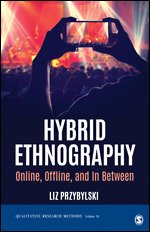Sharing Results from Hybrid Ethnography
by Liz Przybylski
Use the code SAGE30 for a 30% discount on Hybrid Ethnography Online, Offline, and In Between.
Dr. Liz Przybylski is the author of Hybrid Ethnography: Online, Offline, and In Between. The book builds on solid theoretical and methodological foundations, and their advice about addressing ethical dilemmas and preparing for ethics review will be greatly appreciated by readers preparing research proposals. In this post they offer suggestions for publishing visually-rich ethnographic research. In the video interview, Liz gives valuable background about the book and offers practical suggestions. See her related Methodspace post, “Ethics & Ethnography” and find more publications and resources on her website:https://drlp.hcommons.org.
Hybrid online/offline research can be shared using a variety of narrative strategies.
What we read—and who we read—impacts how we write. This is an invitation to read widely, to diversify who we read, and then to select sources that speak to us for deep analytical reads and re-reads. As ethnographers, we produce results that can be shared in the form of an academic article or monograph. At the same time, integrating digital and physical spaces invites other formats for sharing information, including short films, radio broadcasts, podcasts, web sites, and popular press articles. When preparing to share your writing or other media, consider:
Privacy: Respect participant preference, and be realistic about how much privacy you can promise. Some participants may want the positive publicity that can come from sharing research information, especially when working with artists in expressive culture. Across your writing, choose which information is appropriate to share given the specific audience.
Format: Where you have permission to do so, consider sharing other media in addition to formal write-ups. Photos, maps, video clips, songs, or interview transcripts can be of interest to an audience. For online written publications, embedding video, audio, and color images can enrich your text and engage your readership.
Style: Writing style is important to consider, and it is a real choice. Even for academic publications, there is no one correct style or tone for presenting research. Write in a manner that feels authentic to you. Additionally, projects that involve collaborative research may be well-suited for collaborative writing.
Access: Sharing results makes content accessible to interested audiences that likely include fellow research participants. Publishing in multiple venues expands accessibility. When reaching wider audiences is the goal, consider venues with shorter timelines to publication, those that use everyday language, venues in the language(s) participants speak comfortably, and those without paywalls for readers/viewers/listeners.











Should you blog about your research? What types of academic blogs serve what purpose?